
- The Savvy Promise
At Savvy, our mission is to empower you to make informed financial choices. While we maintain stringent editorial standards, this article may include mentions of products offered by our partners. Here’s how we generate income.
In this article
In addition to researching the financial wellbeing of Australians, Savvy is taking an interest in creating a snapshot of the overall health and wellbeing of Australians. In this article, we delve into the latest reports and surveys into Australian health.
- Tobacco use has fallen to 11% in 2022 from 24% in 1990
- Life satisfaction as of April 2022 sat at 6.7 out of a possible 10
- Life expectancy is 81.2 years for men and 85.3 years for women
- The current cancer survival rate is 70% – up from 52% in 1989-1993
How healthy are we as a nation? Though we may see reports on the news about cancer, obesity, and other lifestyle diseases, we don’t often get a complete picture. According to the Australian Institute of Health and Welfare’s latest Australia’s Health 2022: In Brief report, there are many metrics to study and quantify the health of an entire population.
These statistics cover life expectancy; disease distribution; causes of death; injury causes and deaths; chronic diseases; suicide and self-harm; mental health; environmental factors; and the health and wellbeing system including primary care and hospital care.
So – how healthy are we, and what is the state of healthcare?
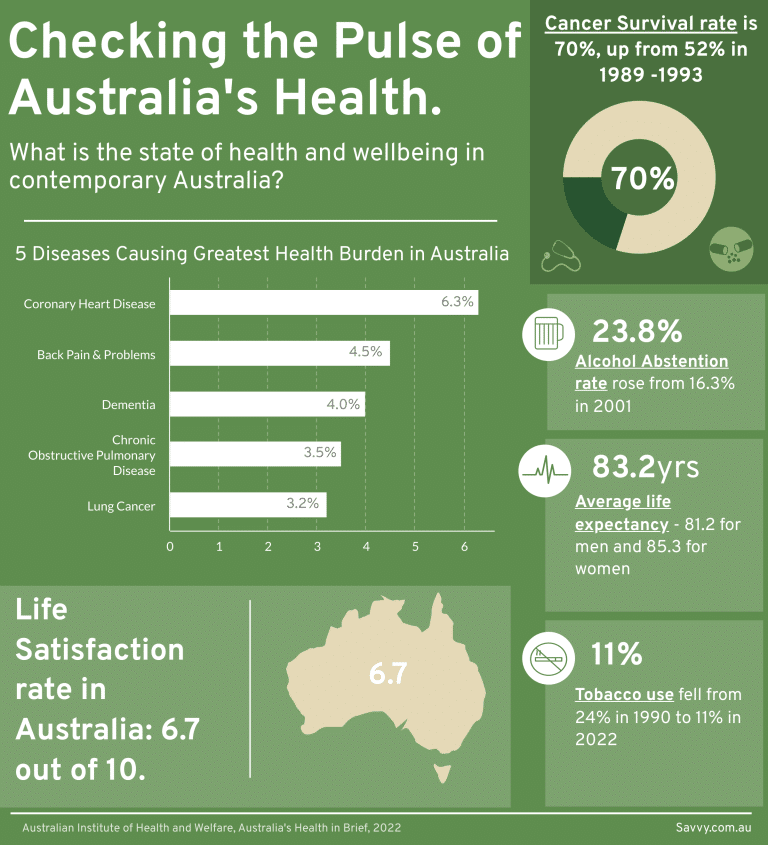
How healthy are Australians?
According to the report, one of the major indicators of health of any nation is life expectancy. At the moment (April 2022) the life expectancy of an Australian is 83.2 years of age – 81.2 years for men and 85.3 years for women. In 1990, men were expected to live 73.9 years; women for 80.1 years.
Over the last century, this has been a dramatic increase – the life expectancy at birth in the early 1900s was about 55 years of age.
The main causes of death in Australia vary by sex. The leading cause for men is coronary heart disease (10,040) followed by dementia (including Alzheimer’s disease) (5,250), and lung cancer (4,751).
For women, the leading cause is Dementia (9,325), followed by coronary heart disease (6,547), and cerebrovascular disease (5,496). Chronic diseases are now the leading causes of premature death – while deaths from infectious diseases are relatively uncommon. Chronic conditions are more prevalent in the over 45s demographic – external causes such as accidents and suicide are the leading causes for those aged under 44.
The burden of disease
In 2018, Australians lost five million collective years of healthy life due to living with non-fatal illnesses (52%) or dying prematurely (48%) which represents the total burden.
The three most leading cause of diseases were coronary heart disease (6.3%), back pain and musculoskeletal problems (4.5%) and dementia (4%). Men generally experienced more of the burden than women before the age of 85, due to a higher-than-average fatality rate. Men experienced more cancers, cardiovascular diseases and injuries compared with women; while women experienced more musculoskeletal, neurological diseases, and respiratory problems.
As for chronic conditions, 47% or 11.6 million Australians were estimated to be living with one or more of 10 selected chronic conditions such as asthma, arthritis, back pain, diabetes, depression/anxiety, etc.
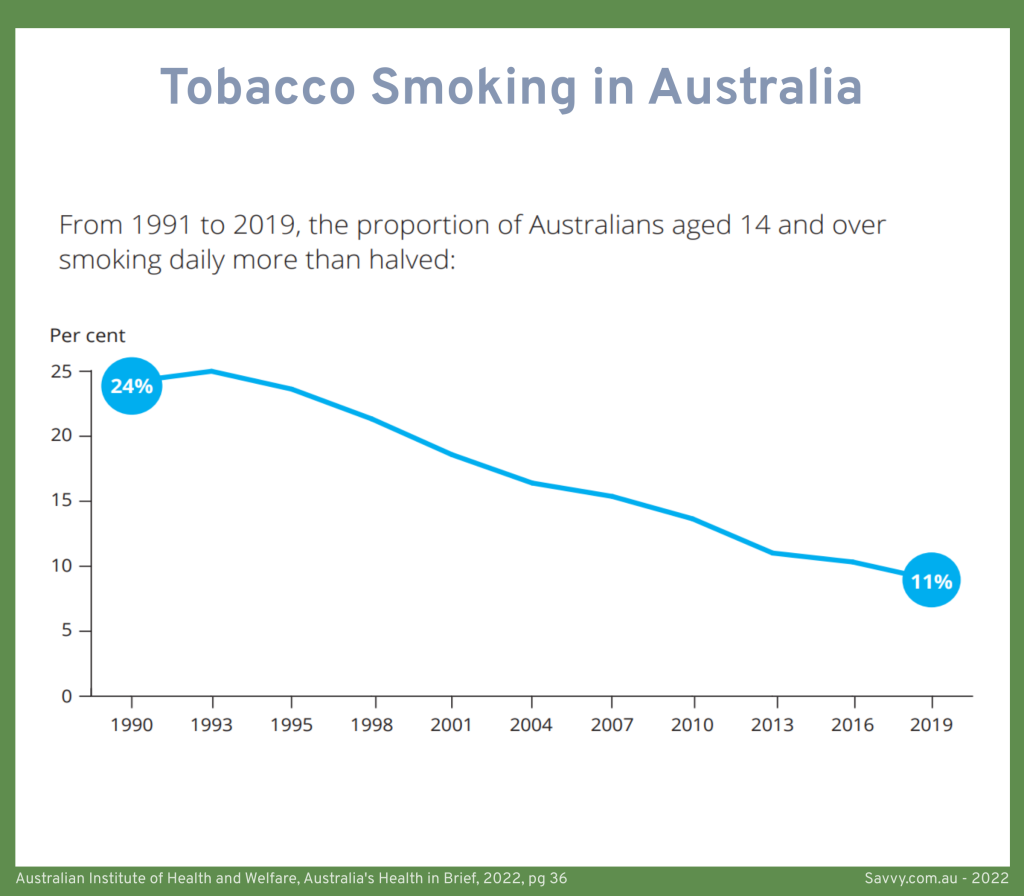
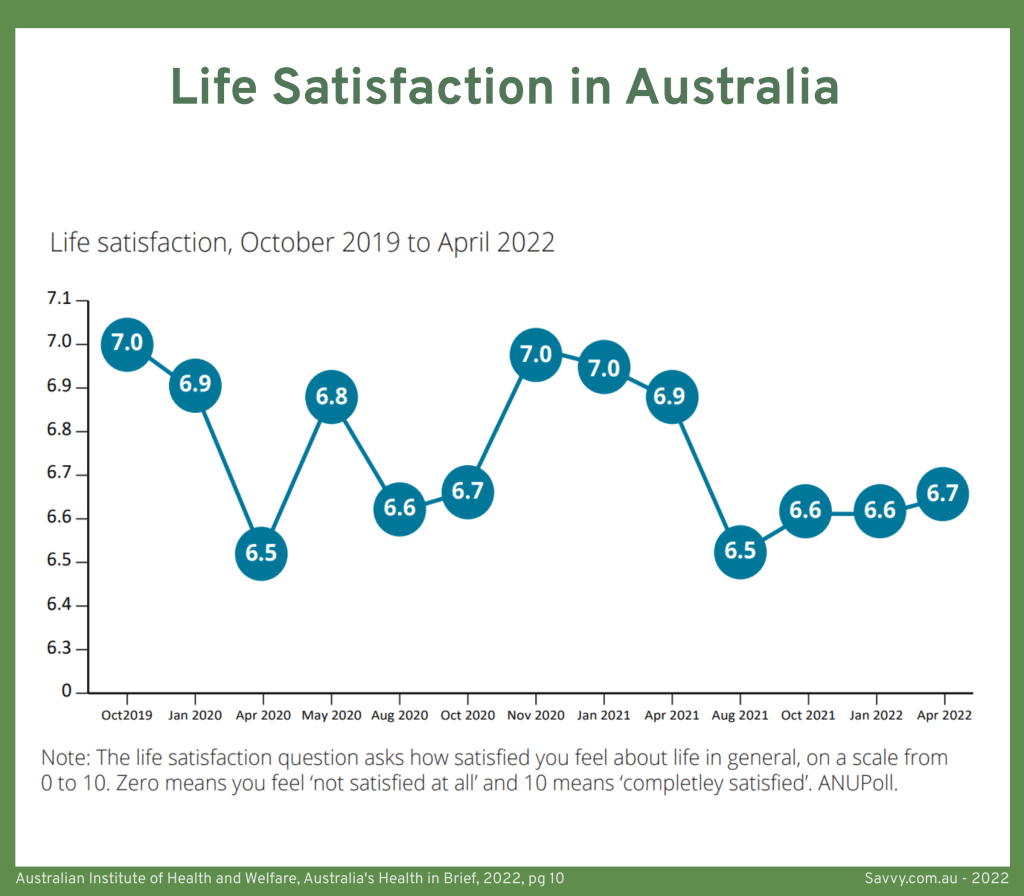
The Big C – survival rates improving
Thankfully, five-year cancer survival rates are increasing – now at 70% in 2014-2018. This represents a 18% increase over 1989-1993 (52%). This contributed to 18% of the total burden of disease in 2018 and accounted for 8.8% of all health system spending in 2018-19.
In 2022, the AIHW estimated that about 162,000 new cases of cancer were diagnosed in Australia; prostate cancer being the most common cancer in men (24,217 cases) and breast cancer being the most common in women (20,428 cases).
Chronic conditions
The AIHW estimates that three in ten or 27% of Australians have some kind of musculoskeletal condition such as arthritis, back pain, or osteoporosis in 2020-21. 1 in 20 people were living with a type (type 1, 2 or other) of diabetes in 2020.
10% of people had markers of chronic kidney disease in 2011-12; and 30% of the population had a chronic respiratory condition such as hay fever, asthma, or chronic sinusitis in 2020-21.
Between 386,200 and 472,000 Australians were living with dementia in 2021, and 387,000 people over the age of 15 had a stroke at some point during 2018.
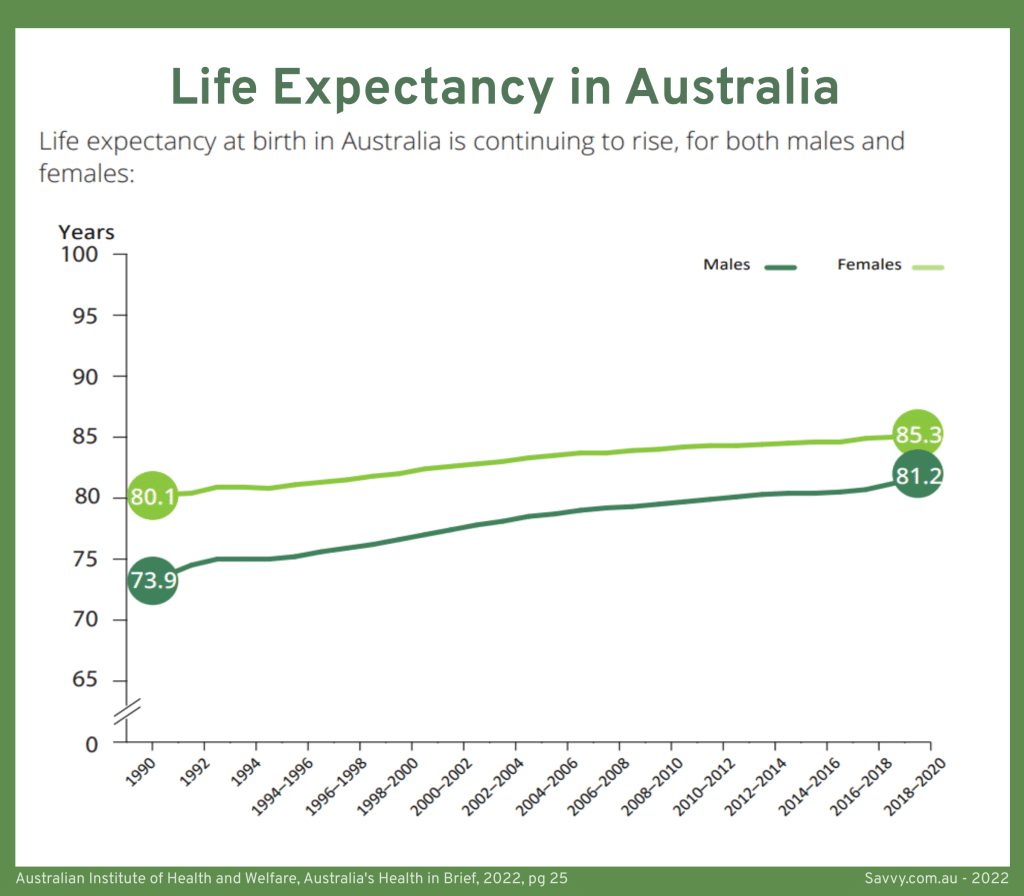
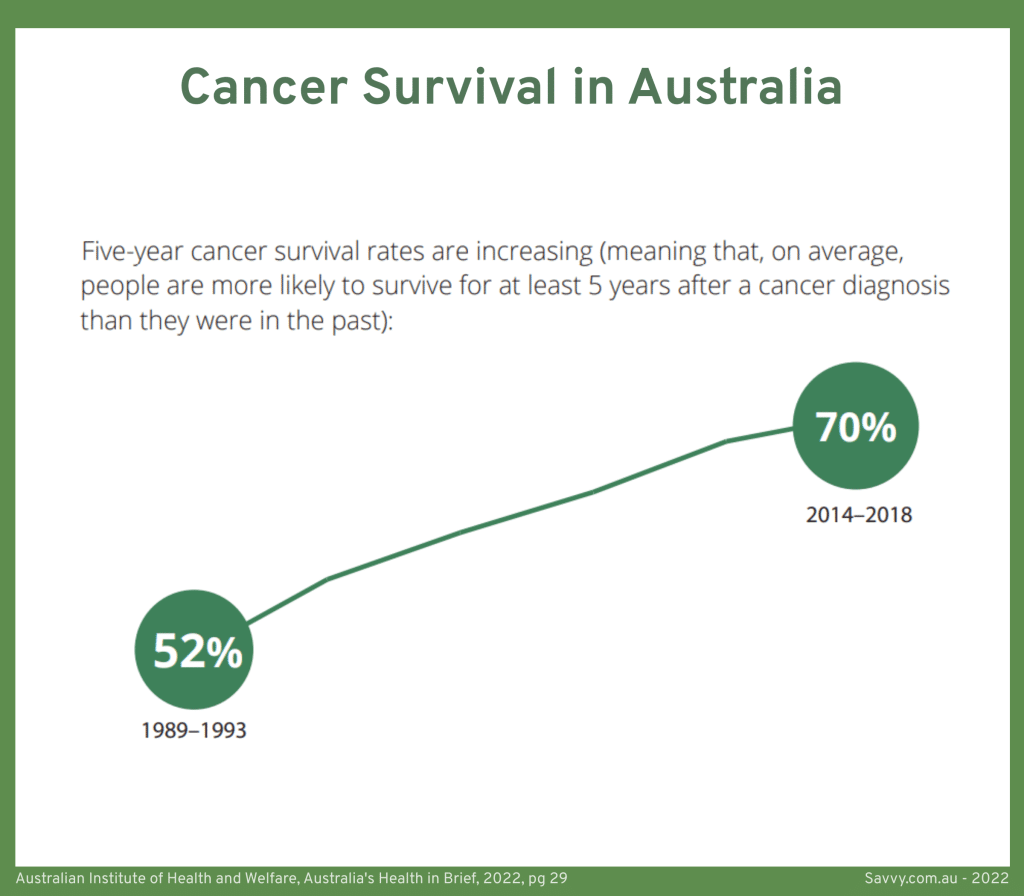
Mental illness in Australia
In 2007, an estimated 1 in 2 or 46% of Australians aged between 16-85 experienced some measure of mental health disorder during their lifetime.
A higher proportion of men (48% compared to 43%) experienced a mental health disorder. People between the ages of 16 and 24 were the most likely to have experienced symptoms of mental health disorders in the previous 12 months.
An average of nine people died every day by suicide in 2020. More than half (52%) were people between the ages of 30-59, compared with 24% for those aged 15-29, and 23% for those over 60.
Suicide is the leading cause of death for young people aged 15-24 – but the suicide rates by comparison are higher for those in their 40s. The highest suicide rate is found in men between the ages of 40-44 and 50-54 – 27.1 per 100,000 heads of population.
Leading causes of injury related deaths
Most injury related deaths were caused by accidental falls (40%), followed by suicide (24%) and accidental poisoning (11%). Interestingly, car accidents doesn't make the top three.
Other leading causes were transport accidents and choking/suffocation. Injuries accounted for 2,200 hospitalisations per 100,000 population and 53 deaths per 100,000 population.
Risks to our health
In 2018, over one-third of diseases were preventable as they were primarily related to lifestyle choices. For example, the three greatest risks to health were tobacco use (8.6% of the burden of disease), obesity (8.4%) and dietary risks (5.4%).
Tobacco use is at 11% in Australia – down from 24% in 1990, which represents a halving of use over that period.
Alcohol abuse is still of concern in Australia. In 2019, 77% of the population aged 14 and over had consumed alcohol (a full serving) in the previous twelve months. The trend for binge or risky drinking (over 4 standard drinks in one sitting at least once per month) fell. The abstention (sobriety) rate increased from 16.6% in 2001 to 23.8% in 2019.
Alarmingly, overweight/obesity increased from 57% in 1995 to 67% in 2017-18, with 75% of men being overweight compared with 60% of women. 27% of adults aged 18-64 did not exercise for the recommended 150 minutes in a given week.
In 2020-21, 96% of men and 87% of women didn’t consume the recommended servings of vegetables!
1 in 6 women and 1 in 16 men experienced physical and/or sexual violence by a partner since the age of 15.
Demographics of health
The youngest demographic – the infant fatality rate – has significantly decreased from 5 deaths per 1,000 live births in 1998 to 3.2 per 1,000 in 2020.
There were 19.7 deaths per 100,000 in children aged 1-14 in 1998, falling down to 8.6 per 100,000 in 2020.
One in four (24%) of children aged 5-14 were considered overweight or obese. The highest causes of disease burden for children were asthma, anxiety disorders, and depressive disorders.
The death rate for young people aged 15-24 has fallen from 41 deaths per 100,000 in 2009 to 38 per 100,000 in 2020. The leading cause of death were injuries (73%) of which more than half (52%) were suicides.
As mentioned before, older people are living longer – men aged 65 can expect to live another 20.3 years while women aged 65 can expect to live another 23 years in 2020.
About one in six people in Australia or 4.4 million had a disability in 2018, with 1.4 million living with severe or profound disability. People with disability generally report poorer levels of health than those without disability.
In the regions and rural areas, the fatal burden rate (number of years lost due to premature death) was 1.8 times that of those living in major cities.
Australian health compared internationally
Australia performs above average or better than many countries – we have a more desirable rank in terms of life expectancy at birth, cardiovascular disease deaths, infant mortality, perceived health status, and tobacco smoking in the OECD.
However, we rate poorly in terms of cancer incidence (including skin cancer or melanoma), apparent alcohol consumption, and overweight/obesity.
Savvy Spokesperson, Adrian Edlington;
"By and large, Australians are getting healthier by the year thanks to greater awareness, advances in technology, and better living standards," says Adrian. "However, lifestyle diseases are still a big factor in chronic disease and fatalities, especially obesity. Though we need to protect ourselves against injuries and accidents with health insurance, one of the greatest health investments may end up being eating healthy and staying active."
Did you find this page helpful?
Author
Adrian EdlingtonPublished on December 6th, 2022
Last updated on March 15th, 2024
Fact checked
This guide provides general information and does not consider your individual needs, finances or objectives. We do not make any recommendation or suggestion about which product is best for you based on your specific situation and we do not compare all companies in the market, or all products offered by all companies. It’s always important to consider whether professional financial, legal or taxation advice is appropriate for you before choosing or purchasing a financial product.
The content on our website is produced by experts in the field of finance and reviewed as part of our editorial guidelines. We endeavour to keep all information across our site updated with accurate information.










